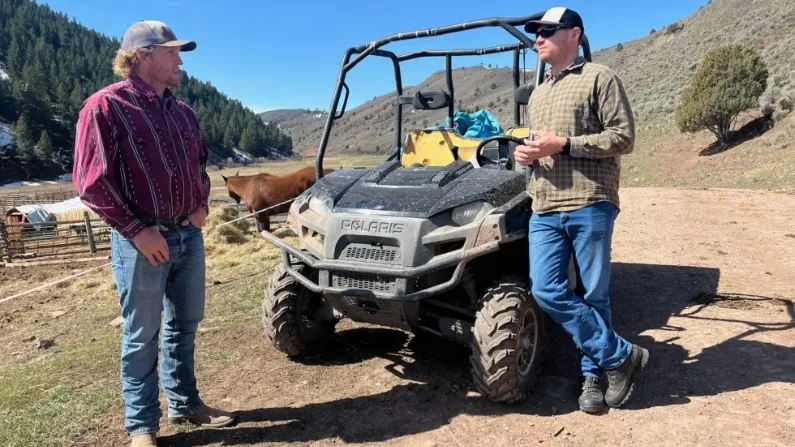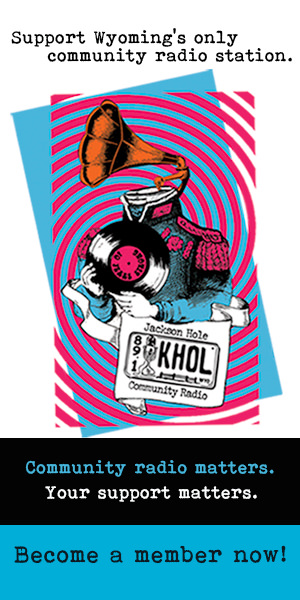Subscribe to Jackson Unpacked. Available wherever you get your podcasts.
The Greater Yellowstone Coalition has started a new strategy to reduce elk dependence on feedgrounds, with most of that work now in Teton County.
Since the start of 2025, chronic wasting disease (CWD) has been detected at four feedgrounds in Northwest Wyoming’s ungulates. Before last year, that number was zero. The jump was expected, as experts believe feedgrounds bring elk too close together, where the the easily transmissible, always fatal brain disease can spread.
KHOL’s Dante Filpula Ankney spoke with the Greater Yellowstone Coalition’s Teddy Collins about how the novel approach to share the cost of shipping cattle in winter aims for a “win-win-win” for ranchers, cattle and elk.
Dante Filpula Ankney: What is an elk occupancy agreement?
Teddy Collins: So these agreements are intended to reduce the reliance of elk feeding through tolerance for elk on private lands, mitigating conflict with elk on private ranch lands. As you know, elk are fed in Northwest Wyoming, both on the National Elk Refuge and on 21 state-run elk feedgrounds. These programs and practices have been around for a long time, almost over 100 years. And there are negative repercussions of feeding elk, primarily disease transmission. So our agreements aim to allow elk to naturally disperse on winter range, and with the intention being that there will be less disease transmission if elk roaming, free-ranging on winter range as opposed to congested on feedgrounds.
DFA: This sounds like kind of a novel concept in Wyoming, as of right now. I wonder if you could explain how it works.
TC: In 2018 and 2019, we were discussing ways to alleviate the need for supplemental feeding efforts, recognizing the threat of disease transmission. There’s also a threat of disease transmission from elk to cattle. And the primary disease in that realm is brucellosis, which has serious financial implications to ranchers. So looking at these ranches that are near or adjacent to elk feedgrounds and the National Elk Refuge, we were brainstorming how to allow elk to utilize previously inaccessible winter range or winter range that wasn’t tolerated for elk while also reducing any conflict or risks for landowners. So there is a history of producers in Teton County shipping their cattle away from Teton County for the winter months and to areas with milder winter range and so the cattle don’t need to navigate the severe winters in Teton County. So we entered into two agreements with producers here in the valley that cost share the shipment of cattle away from the ranch for the winter months. So from December 1st to April 1st, the ranches are devoid of cattle. That benefits the producer because their cattle are in milder temperatures and there isn’t a potential for elk co-mingling with cattle on the ranch. That’s a win for us because it allows the ranch to act as winter range for elk that can naturally distribute and not compete with cattle. So it’s a win-win for both the livestock producer and the conservation goal of increasing winter range and reducing reliance on the feedgrounds.
DFA: I wonder if you or the Greater Yellowstone Coalition has heard any pushback on this idea.
TC: Well, there’s pushback to the concept of reducing feedgrounds and reducing the reliance on supplemental feeding efforts. It’s a tradition. It’s been around for over a hundred years. And the feedgrounds were initially started to reduce winter mortality of elk and reduce conflict with cattle ranches and they do a good job of reducing that conflict. But the negative repercussions, specifically disease transmission, have risen to the forefront of science and policy in the state of Wyoming. And just this winter we’ve had four feedgrounds have positive tests for chronic wasting disease. And this is a huge threat to ungulate herds of western Wyoming. And also Wyoming is the only state that has a feedground policy. Other states have recognized the threats of feeding elk and the threats that come with unnatural distribution and unnatural crowding. We recognize that there is a cultural and a social connection to the practice of feeding elk, but we are interested in innovative and new solutions that reduce that need while also recognizing the needs of livestock producers.
DFA: How many of these exist right now?
TC: We have three agreements currently, two in Teton County and a new agreement that we signed in Lincoln County. The goal is for this project and these agreements to grow and spread and so we are hopefully looking to sign an agreement in Sublette County, which contains a significant amount of the elk feedgrounds in the state and really provide a concept that can be utilized as a tool by state agency officials, Wyoming Game and Fish Department, and private landowners.
DFA: Is this tool scalable? Do you think you can accomplish that goal?
TC: Currently, the agreements are funded through private philanthropy, through a generous donation from the Knobloch Family Foundation. It is our intent to prove this concept can work, then have the Wyoming Game and Fish Department adopt this practice as a state practice. There have been winters where the budget for feedgrounds has exceeded $3 million dollars. If some of that money was reduced, if feedgrounds were reduced, then theoretically that those funds could go towards this types of agreements that utilize winter range on private lands
DFA: How close of a reality is that?
Collins: Well, it’s still speculative at this point, but we have been clear that this project may not exist with private funding forever and that it is our intention to prove a concept and have the Wyoming Game and Fish Department adopt this practice.
Dante: Is there anything else that you’d like to add before we get off here?
Collins: These are innovative and these are voluntary and we are just trying to provide a tool for private landowners and state agency personnel to navigate a really complex topic.






